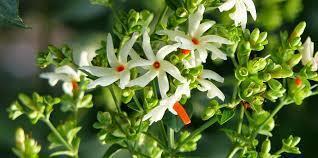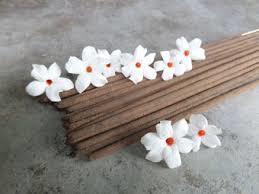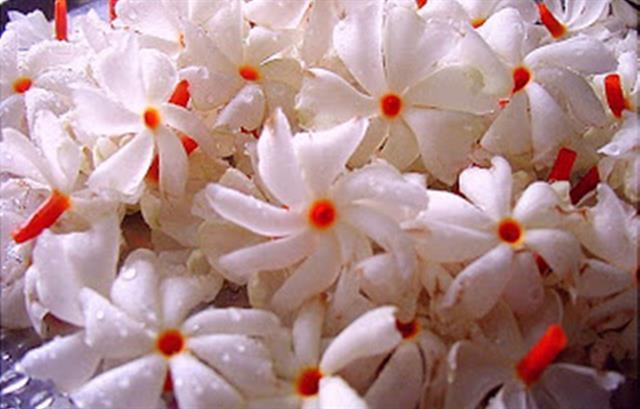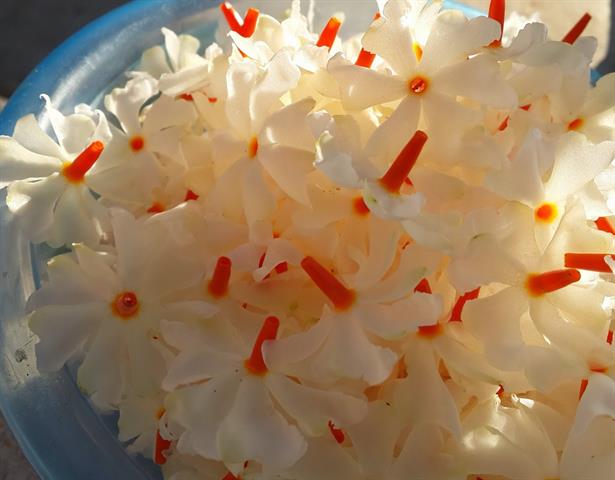PARIJATA
Contents
- Introduction
- Description of the tree
- Puranic Reference
- Ayurvedic uses
- Significance
Introduction
Parijata is a divine flower revered in India. The botanical name of Parijata is Nyctanthes arbor-trestis. Nyctanthes means a flower which blooms in the night and arbor-trestis means a “sad tree”. Thus it is also known as the “tree of sorrow”, as the flowers bloom in the late evening and wither with the first rays of sun falling on them at dawn. The tree looks sad in the morning. Parijata is the State flower of West Bengal.

It belongs to the family of Oleaceae. It is known as Prajakta/Prajakt Nishipushpika or Mandara in Sanskrit. The other names of the flower are: Singgarei in Manipuri, Sewali (pronounced as Xewali) in Assamese, Shefali Or Shiuli in Bengali, Shephalika, Parijata, Parijataka, Ragapushpi, Kharapatraka, Nalakumkumaka, Harsingarapushpak in Hindi, meaning the ornament of Lord Hari, Suklangi, Rajanihasa, Malika, Aparajitha, Vijaya, Nisahasa, Praharshini, Pravalanalika, Vathari, Bhoothakeshi, Seetamanjari, Subaha, Ganga Shiuli in Oriya, Paarijaatham or Pagadamalle in Telegu, Paarijaata or Goli in Kannda, Paarijaat or Paarijatak in Marathi, Pavazha malli (also spelled as Pavazha malli or Pavala malli) and Pavizha malli in Malayalam, Coral Jasmine or the Night Flowering Jasmine in English. Parijata is the State flower of West Bengal.
Description of the tree
Parijata is a deciduous shrub or a small tree that grows to a height of 10 mts. The leaves are opposite, and grow up to 6-12 cm in length. Its aromatic flowers consist of five to eight lobed white petals with an orange red pin-wheeled stalk in the centre. The flowers bloom in clusters of two to seven together. Flowering season is from June- December. The tree is mostly found in the premises of temples. The flowers which bloom in the evening emanate a refreshing fragrance.
The fruit is flat brown in colour. It is heart shaped or nearly round and has two sections with a single seed in each section. The tree is propagated through seeds or by cuttings.
The tree is a native of South Asia and South East Asia. Parijata is grown in the Himalayan region, Jammu & Kashmir, East Assam, Bengal, Tripura extended up to the central region of Godavari in the South. The tree is also found in Thailand, Indonesia, Nepal, and Pakistan.
Puranic Reference:
According to Bhagavad Purana, the tree emerged during the Samudra Manthana or the Churning of the Ocean. During the churning of the Ocean, many objects emerged from the ocean and one among them was the Parijata or the Mandara tree. Lord Indra took the tree and planted it in Deva loka. Sage Narada brought some flowers from Indra Loka and gave it to Lord Krishna. Sri Krishna gave the flowers to his beloved wife Rukmini. On seeing this, Sage Narada, told Satyabhama about the flowers being given to Rukmini. Having aroused enough jealousy in Satyabhama about Rukmini, Sage Narada offered a solution to her problem. He told Satyabhama to urge Sri Krishna to get the Parijata tree from the Indraloka and plant it in her courtyard, instead of few flowers. When Sri Krishna entered Satyabhama’s palace, she expressed her displeasure about the entire incident and insisted that He get the plant from Indraloka.
Meanwhile, Sage Narada warned Lord Indra that Sri Krishna would come to take the celestial Parijata plant from Indraloka. When Sri Krishna and Satyabhama were about to leave Indraloka after taking a branch of the tree, a fight ensued between Sri Krishna and Indra, as Lord Indra did not want to part with the Parijata tree. Indra lost the battle and had to give away the Parijata plant to Sri Krishna. However, he cursed the plant saying that it would not bear fruits. Thus the Parijata tree never bears fruits.
Having brought the tree from Indraloka, Rukmini was enchanted with the fragrance of the flower. Sri Krishna, with the objective of pleasing both His consorts, planted the tree in such a way that the flowers would fall in the courtyard of Rukmini, though the tree was planted in Satyabhama’s courtyard. Thus Sri Krishna fulfilled the wishes of both Satyabhama and Rukmini. Satyabhama wanted the tree, so the tree was planted in her courtyard, and Rukmini wanted the flowers, so the flowers fell in her courtyard.
A Parijata tree located at Kitnur district, in Barabanki district of Uttar Pradesh belongs to the Mahabharata period.
Another reference is that once queen Parijataka wanted to marry the Sun god- Lord Surya. But when the Sun god rejected her love, the queen committed suicide and a tree sprung from her ashes. The tree came to be called as Parijata or Parijataka. Unable to bear the sight of her lover- the Sun god, the tree flowers only during the night and sheds, the flowers (as tear drops) with the first rays of the sun falling on the flowers.
Ayurvedic Uses
Parijata, the divine tree has immense medicinal properties. Its leaves, flowers, seeds and bark are used in various ayurvedic preparations. The flower is known as Kalpavriksha as it is used as a panacea for several ailments. Extracts of the seeds, flowers and leaves possesses immunostimulant, hepatoprotective antiviral and anti fungal activities in vitro.

Flowers
The flowers contain essential oils, nyctanthin, D-mannitol, tannins, glucose, carotenoids, glycosides including β-monogentiobioside ester of α-crocetin (or crocin-3), β-monogentiobioside-β-D monoglucoside ester of α-crocetin, and β-digentiobioside ester of α-crocetin (or crocin-1).
Flowers are diuretic, anti bilious, anti oxidant, anti inflammatory, sedative and anti filarial in nature. The flowers are used as a face pack which makes the skin glow. Flowers are used to treat piles, constipation, fevers, rheumatism, Jaundice, Sciatica, dry cough, ring worm, intestinal problems and for all women related ailments. Flowers are effective in the treatment of lies and dandruff. Flowers are used in preventing the excessive secretion of Bile by liver. It is effective in toning the stomach, prevents gas formation and cures cough. A soup made out of the flowers taken early in the morning acts as an energiser. Dried flowers are used as components of a recipe in Assamese food.
Bark: The bark contains glycosides and alkaloids. Bark is used to treat swelling of lungs. The oil extracted from the bark is used to treat eye pain and as a hair tonic.
Stem: The stem contains the glycoside naringenin -4’-0-β- glucapyranosyl-a-xylopyranoside and β-sitosterol. The stem is effective in the treatment of malaria and rheumatic joint pain. A decoction of the stem boiled in water along with ginger and long pepper, taken twice a day is used to treat malaria.

Flower oil: The flower oil contains a-pinene, p-cymene, 1-hexanol, methylheptanone, phenyl acetaldehyde and 1-decenol andanisaldehyde.
Seeds: seeds have antibacterial, antifungal, immunomodulatory and antileishmanial properties.
Leaves: Leaves contain D- mannitol, β-sitosterol, flavanol glycosides, astragalin, nicotiflorin, oleanolic acid, nyctanthic acid, tannic acid, ascorbic acid, methyl salicylate, an amorphous glycoside, an amorphous resin, trace of volatile oil, carotene, lupeol, mannitol, glucose, fructose, iridoid, glycosides and benzonic acid.
Leaves are used in Ayurvedic and homeopathic medicine for sciatica, arthritis, fevers and for several painful conditions. Leaves are used as laxative too. The leaves have anti arthritic properties. It is effective in the treatment of all types of inflammation and fever including malaria, intermittent fever, common cough and cold.
The juice of the leaves which tastes saline and bitter, mixed with sugar is used an antidote to treat various stomach ailments in children. The decoction of the leaves possess properties that protect the liver, anti-viral, anti-fungal, analgesic, antipyretic, anti-inflammatory antispasmodic, hypotensive and respiratory stimulant activities. Juice of the leaves mixed with honey is effective in the treatment of chronic fever and cough. The juice acts as an appetiser and provides a soothing effect in the stomach.
A decoction of the leaves boiled in water is effective in treating joint pains, swelling and Sciatica.
A paste of the leaves when applied on skin cures ring worm associated skin ailments.

Seeds
The seeds contain arbortristosides-A and B, glycerides of linoleic, oleic, lignoceric, stearic, palmitic, and myristic acids; nyctanthic acid; 3,4- secotriterpene acid, and a water soluble polysaccharide composed of D- glucose and D- mannose. Seeds have antibacterial, antifungal, immunomodulatory and anti- leishmanial properties. Seeds are effective in the treatment of constipation and skin ailments.
Other uses The leaves are used for polishing wood and ivory.
Significance
Parijata flowers signify the arrival of the Durga Puja.
In the ancient days, the robes of the monks were dyed using the orange of the Parijata flower. The flower which withers on the ground is collected and the orange stalk is separated from the white petals. These stalks are then dried and were used as a dye for the clothes.
The white petals of the flower signify purity, while the orange colour in the centre symbolises fire, Agni, which destroys the worldly pleasures and makes one concentrate on the higher Self. The orange colour robes used by monks signify the renunciation of worldly pleasures.
Parijata flower is the only flower which can be offered to the Lord though it falls on the ground.
The scent of the flower is used in making incense sticks and attar.
In Assam, the flowers are used in cuisine, as they are rich in medicinal properties.
The wood of the Parijata tree is considered sacred and is offered in Homa/ Havan.
https://in.answers.yahoo.com/question/index?qid=20110120062932AArKy42
http://www.vidyaonline.org/dl/shaktigupta.pdf
http://en.wikipedia.org/wiki/Nyctanthes_arbor-tristis
http://creative.sulekha.com/parijat-the-flower-of-gods_357448_blog
http://www.whitelotusaromatics.com/newsletters/parijata_2
http://www.bimbima.com/health/post/2012/01/04/medicinal-use-of-harsingar-or-night-jasmine.aspx

